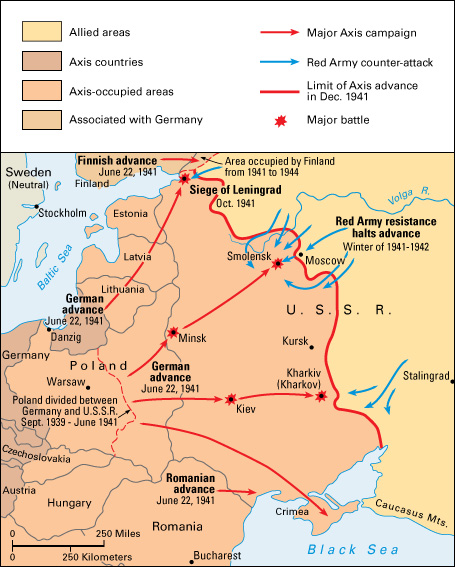Operation Barbarossa was the code name for the German invasion of the Soviet Union during World War II (1939-1945). The goal of the invasion was to crush the Soviet Red Army and bring portions of the Soviet Union under German control. Operation Barbarossa was the largest military operation in history.
Operation Barbarossa began on June 22, 1941. About 3 million German troops—supported by soldiers of countries allied to Germany—at first shattered the Red Army’s defenses. They advanced in three groups with a force of about 3,350 tanks, 7,200 artillery pieces, and 2,770 warplanes. The surprise attack pushed deep into Soviet territory and destroyed thousands of Soviet tanks and warplanes.

The German invasion surrounded Leningrad (now St. Petersburg) and took the Soviet cities of Minsk, Smolensk, Kyiv (also spelled Kiev), and Kharkiv (also spelled Kharkov). By the end of November 1941, the invading troops drew within 20 miles (32 kilometers) of Moscow, the Soviet capital. Soviet resistance stiffened, however, after Soviet commanders brought in troops from eastern Asia. The Germans failed to take Moscow and Leningrad. In addition, they were stopped short of the rich oil fields of the Caucasus region.
Red Army resistance, the harsh Russian winter, and heavy German casualties brought Operation Barbarossa to a halt in December 1941. Germany and other Axis nations lost about 200,000 troops in the operation. The Red Army suffered hundreds of thousands killed and more than 3 million captured.
After Barbarossa failed, the Germans launched further offensives. They attacked in Northern Caucasus at Stalingrad (now Volgograd) in 1942 and in western Russia near the city of Kursk in 1943. After enormous losses on both sides, these operations failed as well. The Red Army eventually drove the Germans back until Germany surrendered in May 1945.
